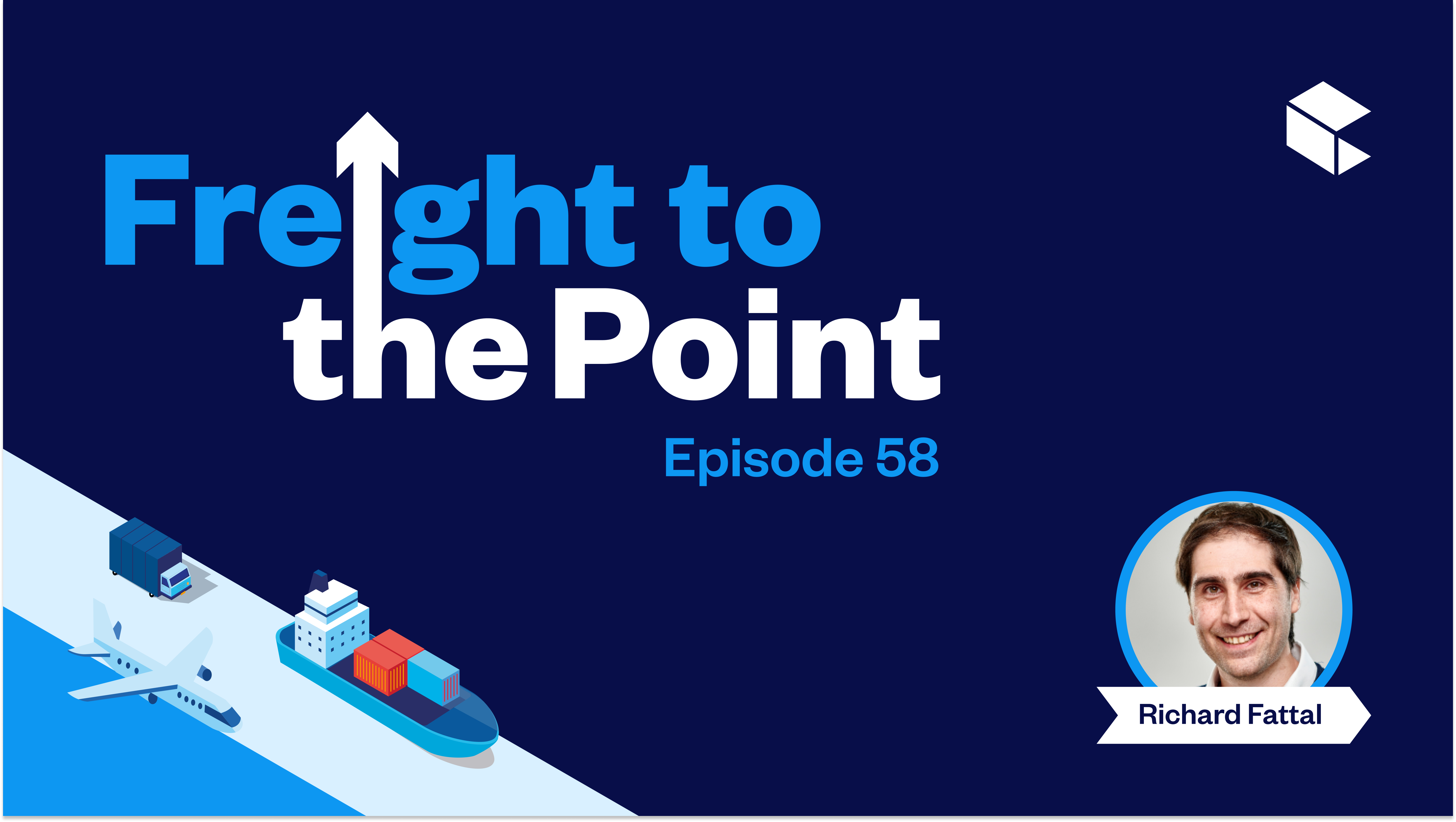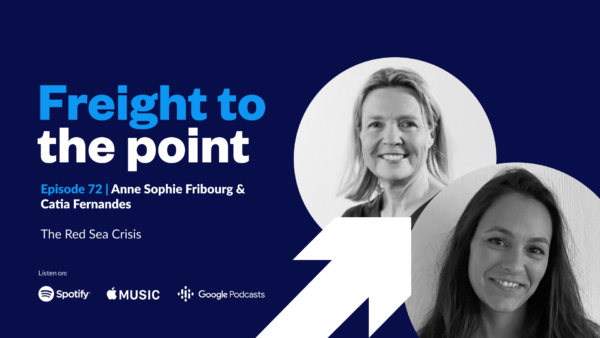Episode 58:
Zencargo's June Ocean Update
See all episodes

Want to find out about our prediction for rate trends over the next couple of months?
Then don’t miss out on the latest episode of Freight to the Point as Anne-Sophie Fribourg, VP of Ocean at Zencargo and Richard Fattal, Chief Commercial Officer and Co-Founder at Zencargo delve into the most recent updates on the ocean market.
They talk about:
- The developing situation in the Panama Canal
- Contract negotiations between ILWU and PMA
- Top rate market tips for shippers
Anne-Sophie Fribourg
Anne-Sophie has over 20 years of experience in the freight forwarding industry, having worked in Singapore, the Middle East region and France for a French freight forwarder. At Zencargo, Anne-Sophie leads the ocean team to obtain the best rates and space and build supply chain resilience for our customers.
Richard Fattal
Richard Fattal is Co-Founder and Chief Commercial Officer of Zencargo, the digital freight forwarder enabling organisations to make smarter decisions through real-time data of their supply chain. Based in London, Zencargo helps customers manage their supply chain such as Swoon Furniture and Ribble Cycles.
Resources
May Ocean Update
Rates strategy consultation
Anne-Sophie Fribourg:
Hi everyone, and welcome to another episode of Freight to the Point I Anne-Sophie Fribourg, Zencargo’s VP of Global Ocean Freight. And today we’ve invited Richard Fattal, Zencargo’s chief commercial officer back on again to talk about what’s happened in our industry in the last months and a half and what shippers should be keeping their eye on. Welcome Richard.
Richard Fattal:
Hi, Anne-Sophie. Thanks so much for having me back on.
Anne-Sophie Fribourg:
Just to give a kind of recap, in the last Ocean update we discussed about the rates in April that were showing signs of rebound, we discussed about capacity that would enter the markets, mainly on Asia-Europe, we had also seen that the volumes in terms of demand were down by significant numbers both on Transpacific and Asia-Europe. So all this doesn’t give us a good visibility on the market and also what we’ve seen is shifts of manufacturing from China to other countries.
So Richard, can you tell us a bit more about this and what has happened in the last months in the industry?
Richard Fattal:
Sure. So I would say it’s been an eventful month in terms of what I would call false alarms. So I think we’re quite used to risk and volatility in globalization supply chains by now and certainly waking up a few weeks ago to the news that there was a vessel stuck in the Suez Canal, something that didn’t shock me as it might once have shocked me. I was very quickly on the phone furiously coming up with action plans for our customers and then I decided to hold back about half an hour to realize that the vessel had been set free and was on its way and there were no problems.
But there have been some developments that did look like they could cause some real risk in the supply chain over the past month. Of particular note, the Panama Canal, which is used for cargo, which is moving particularly from Asia to the East Coast of the United States as one of the key lanes has been drying up. And you might note that on previous calls we’ve explained that a lot of cargo because of the lack of capacity at West Coast ports and because a lot of companies in the United States are moving their warehouses and they’re relocating them has moved from West to East Coast and that means more volume needs to go through the Panama Canal. And there’s been some worry that because the Panama Canal has been drying up and there’s been insufficient rainfall over the last few months, that there wouldn’t be enough capacity in the Panama Canal to cover all of the volume requirements. To give you context, about 6% of global trade goes through the Panama Canal. So I think in 2022 that was 14,000 vessels carrying over 500 million tons of cargo.
Anne-Sophie Fribourg:
Yeah, you are right. But I’ve also read that some shipping lines are discharging cargo for Mexico before entering the canal. So they are already taking measures, I would say, to lighten the ships. But what will be the real impact on the shippers?
Richard Fattal:
So far the shipping lines looked like they were going to try to impose a surcharge, they were also warning about potential delays and potential disruption. We haven’t seen that come to fruition. For the moment, I would say it was more of a, let’s say, false alert. And like general rate increases, which we’ve seen on that lane, which hasn’t yet come to fruition. But I would certainly watch out. We saw in Europe last year the impact of drying out on the canals in mainland Europe. This can have a real impact if it develops further. I think for the moment the capacity is there to support the vessels that are going to the East Coast.
Anne-Sophie Fribourg:
And what about the news that we had last week about the agreement between the Port Maritime Authorities and the ILWU? Maybe that would have an impact on the medium term by diverting some of the cargo that was shifted to the East Coast because of the problems of congestion in the West Coast ports that will move back to the West Coast ports?
Richard Fattal:
Well that’s definitely possible. So you raise a good point. The issue of labor contracts, particularly on the West Coast of the United States. This was the other key risk that’s kind of come up over the last month. It’s always a concern for anyone shipping to the United States and there’s always a threat of disruption because of the strength of the labour union and the extent to which they go through periodic negotiations. And we did see some real risk on the West Coast and we saw people divert cargo in anticipation of that risk. And we saw actually West Coast ports shut down for a period of time. LA was down for a period of time, as well as some of the other West Coast ports. We were concerned that it would be a real disruption.
But obviously in short measure there was a conversation which happened between the West Coast Union, the ILWU and the ports and they reached tentative agreement which involves a 32% salary increase spread over the next six years. And it looks like for now, this is a real positive in terms of potential disruption over the coming months and year on the West Coast and should lead to some rebalancing of volumes between both ports.
Anne-Sophie Fribourg:
Okay. So that should bring a more normal situation, I would say. And what about the rates? What is happening in terms of rates? Because we’ve seen some GRIs on TP that shipping lines have tried to implement in April and May, which was more in order to have better conditions to negotiate the long-term rates, the long-term contracts with the BCOs. But what is your opinion on that?
Richard Fattal:
It felt like the GRIs that were coming in were a little bit opportune in terms of their timing. As you say, May is the key renegotiation point for annual contracts and it was important to have some stability or at least a reduction in the downward trend of the market in time for those key BCO negotiations. What we’ve seen is that those GRIs have not held. Annual negotiations have happened at levels closer to the pre-GRI rate levels than the post-GRI rate levels. And since then we’ve also seen a real kind of lack of peak in this important period of the year. With that said, we do continue to see measures by the carriers to take out capacity and a continuation of blank sailings and therefore the stability of service is something that customers really need to watch out for, even in a market where the rate environment is a little bit more slack.
Anne-Sophie Fribourg:
And we’ve seen also the split of capacity that has been reviewed by some carriers between the major trades TP and Asia-Europe and some European carriers have diverted capacity from TP to Asia-Europe in order to be more present on that trade.
So can we now talk briefly about Asia-Europe and what we’ve seen recently? We know there’s a lot of capacity coming in. There’s 9% added capacity in June versus May. Volumes are a bit better than on transpacific, I would say demand is a bit higher. What is your idea about the evolution of the rates and the trend of this market?
Richard Fattal:
I mean, we are definitely starting to see the new alliance landscape having an impact on the market. So with MSC moving in and introducing the Swan service, which is a standalone service on Asia-Europe, we really start to see that the toolkit that the carriers had in terms of blanking is a little bit impacted by that change in landscape. With the combination of those introductions of new services, but also the addition of vessels that are coming on stream and the lack of regular seasonal Christmastime cargo that we see coming through in July, Asia-Europe trade really does feel rather weak.
With that said, we do continue to see across the more robust alliances, significant blank sailing programs on Asia-Europe, and I would say some bottoming out of rates at levels which really as the kind of Hapag-Lloyd CEO announced just last week are somewhat unsustainable for the shipping lines. So I would really see kind of the Asia-Europe trade as now really operating at let’s say long term unsustainable levels. I would anticipate shippers wanting to kind of lock in longer term contracts at these levels and shipping lines, really trying to mitigate the risk of any further deterioration in rates.
Anne-Sophie Fribourg:
So what would you advise our customers? There is still good opportunities to do on the spot market. But when we would like to have a sustainable supply chain, what is your advice in these volatile markets for the coming weeks?
Richard Fattal:
From a rate perspective, I think you’re now at levels where when you divide it into the cost of goods sold of any higher margin or middle margin product, the freight is really starting to become much less of a significant cost component and now it’s really important to focus on service. So I wouldn’t be thinking about the spot market as a key advantage in terms of price at this point. I think you can certainly look to lock in a rate for a month, a quarter, or even a longer period of time with some stability and an allocation associated to it. And I think that that’s a really important thing to look at doing at this time.
The only thing I would say to that is, I do think it’s important that you leave some capacity to have flexibility at this point because you can agree on an agreement with a particular shipping line and that shipping line might at these levels enter into more robust blank sailing programs, which might mean that the service is affected. So I would say if you can contract with a supply chain partner to offer you a couple of shipping lines, a regularity of volume at a reasonable rate, which is at the sorts of levels we’ve been experiencing in more recent weeks or even even a touch higher, that you’ll certainly have sustainability and a reduction of risk in your supply chain at this point. And I think that makes a lot of sense. I think it’s very important to balance service options and regularity and space protection with the rate at this point, especially just given where we are in the market. I mean you’re talking about record low levels on the Asia-Europe trade.
Anne-Sophie Fribourg:
And I’m sure shipping lines would be good to provide the competitive long-term rates knowing that they are launching their new services, they are bringing in new ships. We saw that the latest ships from the Alliance are being launched, 24,000 TEU ships, LNG dual ships. I think provided our customers give good forecast, they will be able to commit to rates and deliver.
Richard Fattal:
Well, I think that’s really what’s key. I couldn’t agree more Anne-Sophie. So now it’s really key that you are looking at your supply chain, you are working with a partner, if you can work very closely with your factories to get a more accurate weekly and monthly forecast of volumes and you can stick to that forecast, you can build up a track record against a contract. And at these kind of levels you can benefit from stability going into the rest of the year, at levels that will really help the cost base of your supply chain.
Anne-Sophie Fribourg:
That’s it for today. So thanks to you and thanks to our listeners for turning into this episode of Freight to the Point. Don’t forget to like and subscribe to our show. And if you have any feedback on this episode, please do not hesitate to reach out on LinkedIn. But, until our next episode, goodbye.

Episode 72: The Red Sea Crisis
In the latest episode of Freight to the Point, we’ve featured our most rec...

Episode 71: The potential of demand forecasting with artificial intelligence
In the most recent instalment of Freight to the Point, Lucie Phillips, Zen...

Episode 70: Rates: What's next for 2024?
As we prepare for the year ahead, it's crucial to consider the three pillars...

